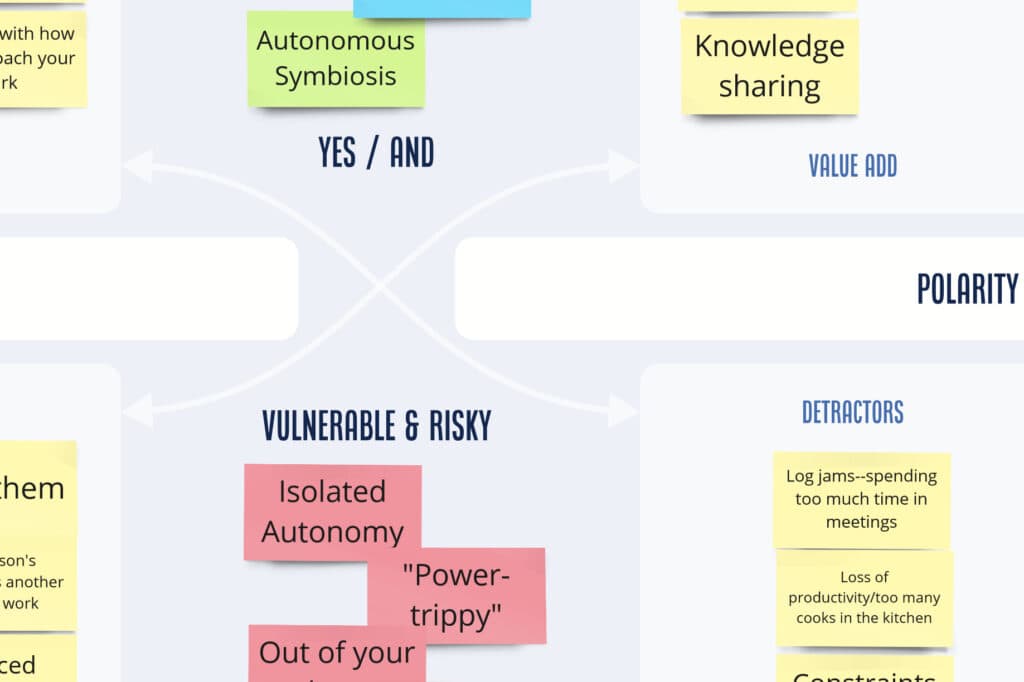The business landscape is rife with dualities that can be both a strength and a challenge. The key to effective leadership lies in navigating these complexities without falling into the trap of extreme positions. We are sharing a Polarity Map template that we use with our clients. It is a dynamic tool designed to help you balance conflicting priorities and make decisions that drive sustainable growth.
What is a Polarity Map?
Inspired by the thought-provoking book, Navigating Polarities, a Polarity Map is more than just a visual tool—it’s a leadership compass. This invaluable resource is crafted to guide leaders in identifying and harmonizing the inherent dualities within their organizations. Whether grappling with the push and pull of centralization versus decentralization or juggling the needs of individual versus team performance, a Polarity Map steers you through these complex terrains with clarity.
But let’s be clear: The real magic happens during the process of creating your Polarity Map. As you actively engage with the tool, you unlock the full range of benefits it has to offer. The completed map serves as a tangible artifact, a snapshot that crystallizes your insights; yet it’s the journey of building it that equips you with the understanding and strategies to navigate your organizational landscape effectively.
Commonly Encountered Polarities
To provide a sense of the diversity and depth of polarities we’ve explored with our clients, here are some illustrative examples:
- Monolith and Distributed Systems. Balancing the solidity of monolithic structures with the flexibility of distributed systems can accelerate innovation.
- Bottom-up and Top-down Leadership. Harmonizing employee autonomy with managerial direction can drive both job satisfaction and organizational effectiveness.
- Transparent and Guarded Information. Finding the right blend between transparency and confidentiality can improve both internal culture and stakeholder relations.
- Siloed and Open Teams. Navigating between specialized expertise and cross-functional collaboration maximizes efficiency and creativity.
- Table Stakes and Product Differentiation Focus. A balanced approach to core offerings and unique features can result in a compelling and marketable product.

Why Balancing Polarities is Essential
Opting for one extreme or another isn’t just limiting; it’s a gamble with the innovative and adaptive potential of your organization.
The art of balancing polarities allows you to harness the strengths of both ends, fostering a dynamic environment where adaptability and innovation thrive. It allows us to help organizations maintain their high performance standards while shifting to compassionate excellence.
Our polarity map template is an effective starting point for visualizing the natural tensions within your teams and organizations.
Ready to Get Started?
Your Guide to Using Heartwired’s Polarity Map
- Identify the Polarity. Begin by naming the conflicting aspects you’re facing and jot them down in the designated areas on the template..
- Map the Quadrants. Use the template to enumerate the strengths and over uses of each polarity.
- Name it. Create a word or phrase that encapsulates your balanced approach to the dualities.
- Open up. Discuss the vulnerabilities and risks that come with blending the two polarities.
- Analyze and Discuss. Examine the map together, drawing on the visual insights to guide your conversation.
- Implement. Formulate action plans based on your insights.
- Review and Adjust. Don’t forget to periodically revisit and update your Polarity Map as conditions change.
At Heartwired, we understand the complex challenges of leading development teams in today’s hectic world. With a unique blend of compassionate leadership and technical expertise, we’re here to support your success. Whether it’s strategy development, team building, or conflict resolution, we’re committed to delivering compassionate excellence.
Schedule your Compassionate & Excellence-Driven Discovery Session